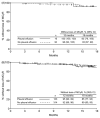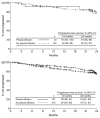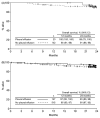Dasatinib 100 mg once daily minimizes the occurrence of pleural effusion in patients with chronic myeloid leukemia in chronic phase and efficacy is unaffected in patients who develop pleural effusion
- PMID: 19924787
- PMCID: PMC4185296
- DOI: 10.1002/cncr.24734
Dasatinib 100 mg once daily minimizes the occurrence of pleural effusion in patients with chronic myeloid leukemia in chronic phase and efficacy is unaffected in patients who develop pleural effusion
Abstract
Background: Dasatinib, a highly potent BCR-ABL inhibitor, is an effective treatment for patients with chronic myeloid leukemia in chronic phase (CML CP) after resistance, suboptimal response, or intolerance to prior imatinib. In a phase 3 dose optimization trial in patients with CML CP (CA180-034), the occurrence of pleural effusion was significantly minimized with dasatinib 100 mg once daily (QD) compared with other treatment arms (70 mg twice daily [twice daily], 140 mg QD, or 50 mg twice daily).
Methods: To investigate the occurrence and management of pleural effusion during dasatinib treatment, and efficacy in patients with or without pleural effusion, data from CA180-034 were analyzed.
Results: With 24-month minimum follow-up, 14% of patients treated with dasatinib 100 mg QD incurred pleural effusion (grade 3: 2%; grade 4: 0%) compared with 23% to 26% in other study arms. The pleural effusion rate showed only a minimal increment from 12 to 24 months. In the 100 mg QD study arm, median time to pleural effusion (any grade) was 315 days, and after pleural effusion, 52% of patients had a transient dose interruption, 35% had a dose reduction, 57% received a diuretic, and 26% received a corticosteroid. Three patients in the 100 mg QD study arm discontinued treatment after pleural effusion. Across all study arms, patients with or without pleural effusion demonstrated similar progression-free and overall survival, and cytogenetic response rates were higher in patients with a pleural effusion.
Conclusions: Pleural effusion is minimized with dasatinib 100 mg QD dosing and its occurrence does not affect short- or long-term efficacy.
Conflict of interest statement
CONFLICT OF INTEREST DISCLOSURES
Funding for the clinical trial, statistical analysis, and medical writing assistance was provided by Bristol-Myers Squibb (BMS). Kimmo Porkka has acted as a consultant, received honoraria, and received research funding from BMS and Novartis. H. Jean Khoury has received honoraria from BMS, Novartis, and Genzyme. Ronald L. Paquette has acted as a consultant for BMS, Alexion, and Telik, and has received honoraria and is a member of the Speakers Bureau for BMS and Novartis. Yousif Matloub and Ritwik Sinha own equity in and are employees of BMS. Yousif Matloub owns equity in GlaxoSmithKline. Jorge E. Cortes has received research funding from BMS, Wyeth, and Novartis.
Figures





References
-
- O’Hare T, Walters DK, Stoffregen EP, et al. In vitro activity of Bcr-Abl inhibitors AMN107 and BMS-354825 against clinically relevant imatinib-resistant Abl kinase domain mutants. Cancer Res. 2005;65:4500–4505. - PubMed
-
- Cortes J, Rousselot P, Kim DW, et al. Dasatinib induces complete hematologic and cytogenetic responses in patients with imatinib-resistant or -intolerant chronic myeloid leukemia in blast crisis. Blood. 2007;109:3207–3213. - PubMed
-
- Guilhot F, Apperley J, Kim DW, et al. Dasatinib induces significant hematologic and cytogenetic responses in patients with imatinib-resistant or -intolerant chronic myeloid leukemia in accelerated phase. Blood. 2007;109:4143–4150. - PubMed
-
- Hochhaus A, Baccarani M, Deininger M, et al. Dasatinib induces durable cytogenetic responses in patients with chronic myelogenous leukemia in chronic phase with resistance or intolerance to imatinib. Leukemia. 2008;22:1200–1206. - PubMed
-
- Ottmann O, Dombret H, Martinelli G, et al. Dasatinib induces rapid hematologic and cytogenetic responses in adult patients with Philadelphia chromosome-positive acute lymphoblastic leukemia with resistance or intolerance to imatinib: interim results of a Phase II study. Blood. 2007;110:2309–2315. - PubMed
Publication types
MeSH terms
Substances
Grants and funding
LinkOut - more resources
Full Text Sources
Medical
Miscellaneous

